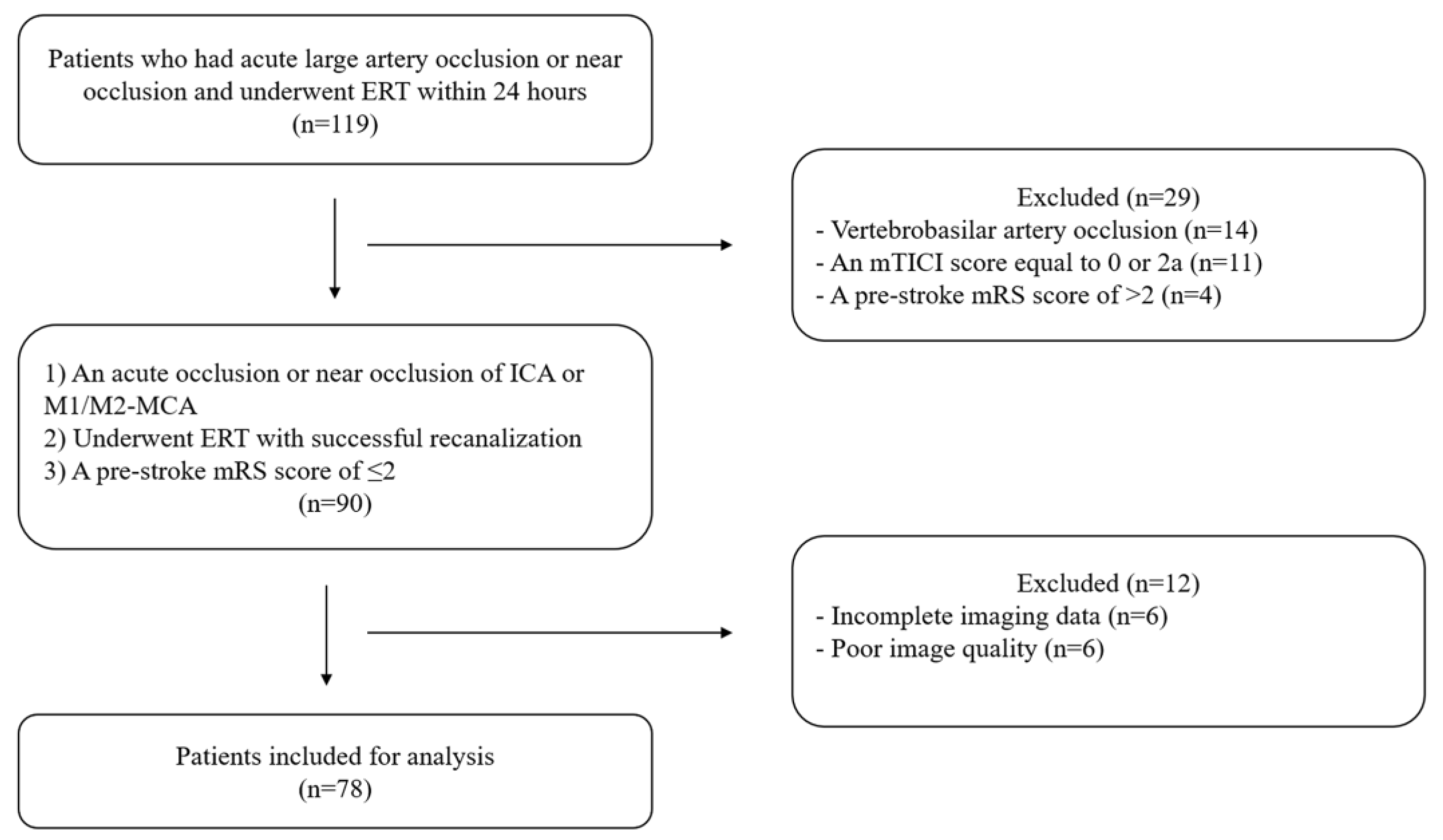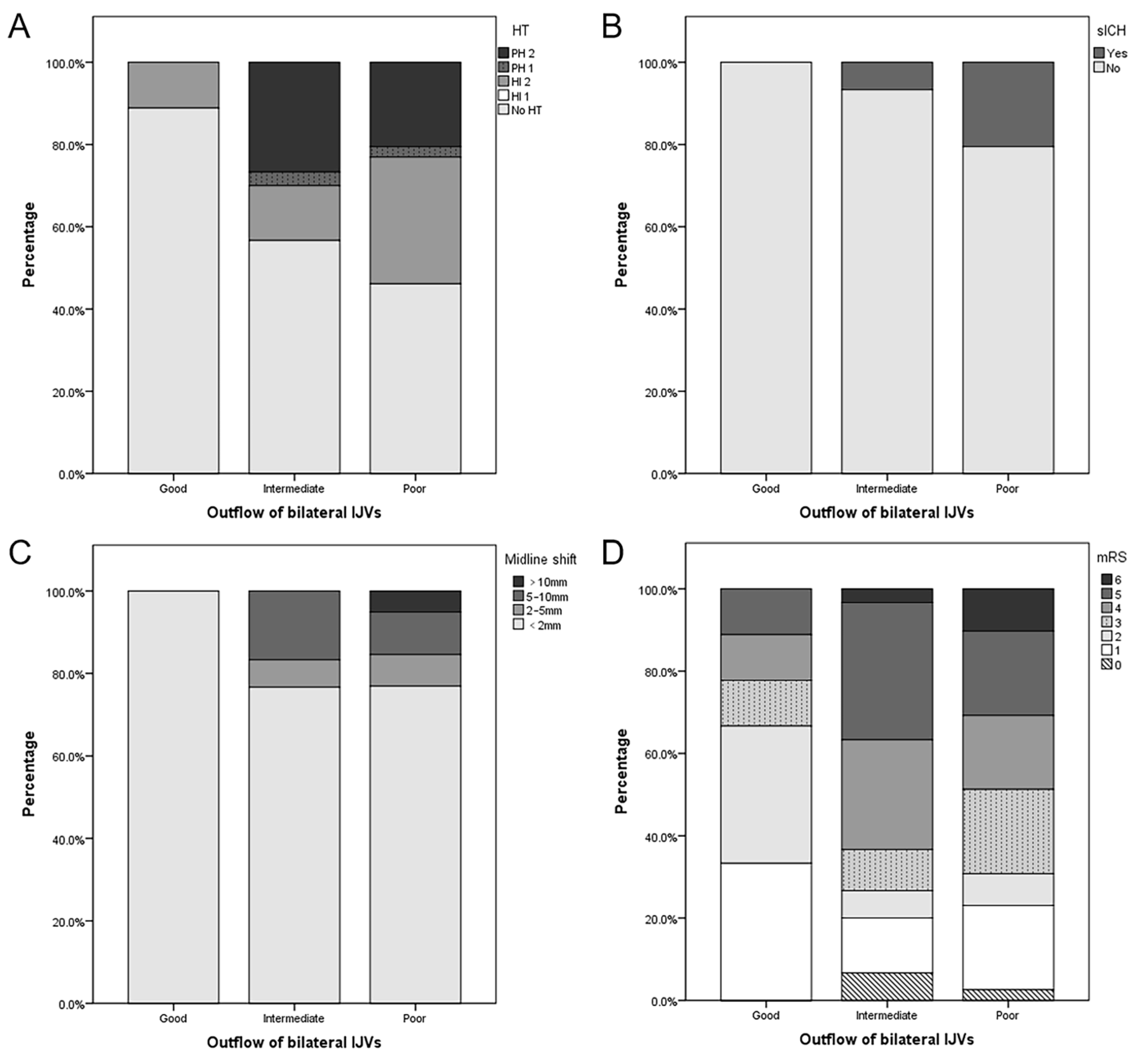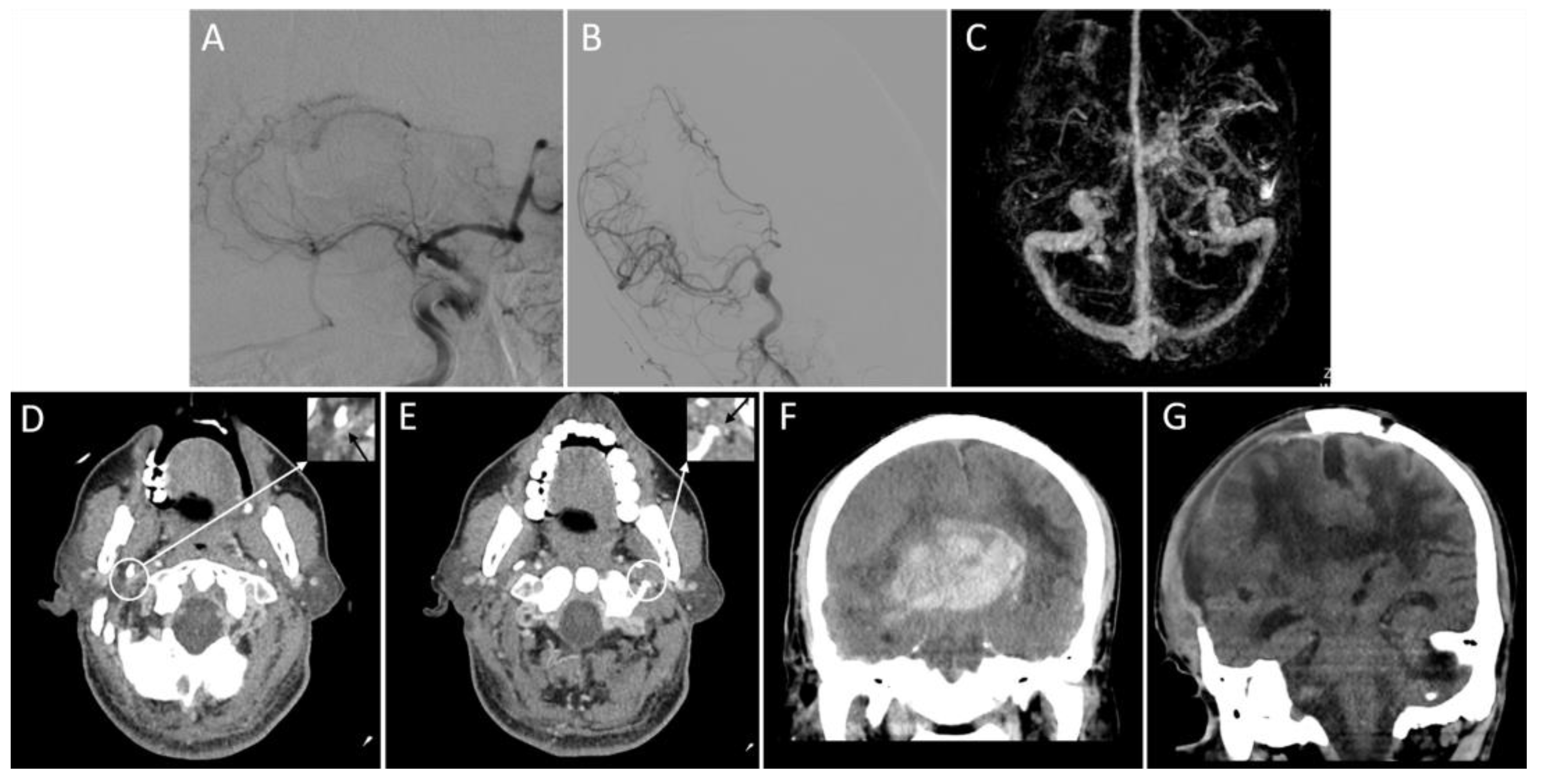Poor Internal Jugular Venous Outflow Is Associated with Poor Cortical Venous Outflow and Outcomes after Successful Endovascular Reperfusion Therapy
Abstract
1. Introduction
2. Materials and Methods
2.1. Patients
2.2. Image Analysis
2.3. Neurological Outcomes
2.4. Statistical Analyses
3. Results
3.1. Patient Characteristics
3.2. Association between the Outflow of TS and IJV on the Affected Side and Outcomes
3.3. Association between the Outflow of Bilateral IJVs and Outcomes
3.4. Association between the Outflow of IJV and Cortical Venous Outflow
4. Discussion
5. Conclusions
Supplementary Materials
Author Contributions
Funding
Institutional Review Board Statement
Informed Consent Statement
Data Availability Statement
Conflicts of Interest
References
- Nogueira, R.G.; Jadhav, A.P.; Haussen, D.C.; Bonafe, A.; Budzik, R.F.; Bhuva, P.; Yavagal, D.R.; Ribo, M.; Cognard, C.; Hanel, R.A.; et al. Thrombectomy 6 to 24 Hours after Stroke with a Mismatch between Deficit and Infarct. N. Engl. J. Med. 2018, 378, 11–21. [Google Scholar] [CrossRef] [PubMed]
- Mocco, J.; Zaidat, O.O.; von Kummer, R.; Yoo, A.J.; Gupta, R.; Lopes, D.; Frei, D.; Shownkeen, H.; Budzik, R.; Ajani, Z.A.; et al. Aspiration thrombectomy after intravenous alteplase versus intravenous alteplase alone. Stroke 2016, 47, 2331–2338. [Google Scholar] [CrossRef] [PubMed]
- Goyal, M.; Menon, B.K.; van Zwam, W.H.; Dippel, D.W.J.; Mitchell, P.J.; Demchuk, A.M.; Dávalos, A.; Majoie, C.B.L.M.; Van Der Lugt, A.; De Miquel, M.A.; et al. Endovascular thrombectomy after large-vessel ischaemic stroke: A meta-analysis of individual patient data from five randomised trials. Lancet 2016, 387, 1723–1731. [Google Scholar] [CrossRef]
- Balami, J.S.; White, P.M.; McMeekin, P.J.; Ford, G.A.; Buchan, A.M. Complications of endovascular treatment for acute ischemic stroke: Prevention and management. Int. J. Stroke 2018, 13, 348–361. [Google Scholar] [CrossRef]
- Campbell, B.C.V.; Mitchell, P.J.; Kleinig, T.J.; Dewey, H.M.; Churilov, L.; Yassi, N.; Yan, B.; Dowling, R.J.; Parsons, M.W.; Oxley, T.J.; et al. Endovascular Therapy for Ischemic Stroke with Perfusion-Imaging Selection. N. Engl. J. Med. 2015, 372, 1009–1018. [Google Scholar] [CrossRef]
- Henninger, N.; Fisher, M. Extending the Time Window for Endovascular and Pharmacological Reperfusion. Transl. Stroke Res. 2016, 7, 284–293. [Google Scholar] [CrossRef] [PubMed]
- Tong, L.S.; Guo, Z.N.; Ou, Y.B.; Yu, Y.N.; Zhang, X.C.; Tang, J.P.; Zhang, J.H.; Lou, M. Cerebral venous collaterals: A new fort for fighting ischemic stroke? Prog. Neurobiol. 2018, 163, 172–193. [Google Scholar] [CrossRef] [PubMed]
- Munuera, J.; Blasco, G.; Hernandez-Perez, M.; Daunis-i-Estadella, P.; Davalos, A.; Liebeskind, D.S.; Wintermark, M.; Demchuk, A.; Menon, B.K.; Thomalla, G.; et al. Venous imaging-based biomarkers in acute ischaemic stroke. J. Neurol. Neurosur. Psychiatry 2017, 88, 62–69. [Google Scholar] [CrossRef] [PubMed]
- Zhang, J.H.; Obenaus, A.; Liebeskind, D.S.; Tang, J.P.; Hartman, R.; Pearce, W.J. Recanalization, reperfusion, and recirculation in stroke. J. Cerebr. Blood Flow Met. 2017, 37, 3818–3823. [Google Scholar] [CrossRef]
- Lin, C.J.; Chang, F.C.; Tsai, F.Y.; Guo, W.Y.; Hung, S.C.; Chen, D.Y.T.; Lin, C.H.; Chang, C.Y. Stenotic Transverse Sinus Predisposes to Poststenting Hyperperfusion Syndrome as Evidenced by Quantitative Analysis of Peritherapeutic Cerebral Circulation Time. Am. J. Neuroradiol. 2014, 35, 1132–1136. [Google Scholar] [CrossRef]
- Nguyen, J.; Nishimura, N.; Fetcho, R.N.; Iadecola, C.; Schaffer, C.B. Occlusion of cortical ascending venules causes blood flow decreases, reversals in flow direction, and vessel dilation in upstream capillaries. J. Cereb. Blood Flow Metab. 2011, 31, 2243–2254. [Google Scholar] [CrossRef] [PubMed]
- Zhang, S.; Zhang, R.T.; Jin, B.; Shi, Z.J.; Li, C.G.; Yu, Y.N.; Wang, Z. Absent filling of the superficial middle cerebral vein is associated with reperfusion but not parenchymal hematoma in stroke patients undergoing thrombectomy: An observational study. Ann. Transl. Med. 2020, 8, 1410–1420. [Google Scholar] [CrossRef] [PubMed]
- Jansen, I.G.H.; van Vuuren, A.B.; van Zwam, W.H.; van den Wijngaard, I.R.; Berkhemer, O.A.; Lingsma, H.F.; Slump, C.H.; van Oostenbrugge, R.J.; Treurniet, K.M.; Dippel, D.W.J.; et al. Absence of cortical vein opacification is associated with lack of intra-arterial therapy benefit in stroke. Radiology 2018, 286, 643–650. [Google Scholar] [CrossRef]
- Winkelmeier, L.; Heit, J.J.; Adusumilli, G.; Geest, V.; Guenego, A.; Broocks, G.; Pruter, J.; Gloyer, N.O.; Meyer, L.; Kniep, H.; et al. Poor venous outflow profiles increase the risk of reperfusion hemorrhage after endovascular treatment. J. Cereb. Blood Flow Metab. 2022, 43, 72–83. [Google Scholar] [CrossRef] [PubMed]
- Faizy, T.D.; Kabiri, R.; Christensen, S.; Mlynash, M.; Kuraitis, G.M.; Broocks, G.; Flottmann, F.; Marks, M.P.; Lansberg, M.G.; Albers, G.W.; et al. Favorable venous outflow profiles correlate with favorable tissue-level collaterals and clinical outcome. Stroke 2021, 52, 1761–1767. [Google Scholar] [CrossRef]
- Liu, S.F.; Liu, P.P.; Wang, P.; Zhang, F.; Wang, L.J.; Wang, Y.; Lu, H.; Ma, X.F. Argatroban increased the basal vein drainage and improved outcomes in acute paraventricular ischemic stroke patients. Med. Sci. Monitor. 2020, 26, e924593. [Google Scholar] [CrossRef]
- Myint, M.Z.; Yeo, L.L.L.; Tan, B.Y.Q.; The, E.Z.; Lim, M.C.; Sia, C.H.; Teoh, H.L.; Sharma, V.K.; Chan, B.A.; Ahmad, A.; et al. Internal cerebral vein asymmetry is an independent predictor of poor functional outcome in endovascular thrombectomy. J. NeuroInterventional. Surg. 2022, 14, 683–687. [Google Scholar] [CrossRef]
- Doepp, F.; Schreiber, S.J.; von Munster, T.; Rademacher, J.; Klingebiel, R.; Valdueza, J.M. How does the blood leave the brain? A systematic ultrasound analysis of cerebral venous drainage patterns. Neuroradiology 2004, 46, 565–570. [Google Scholar] [CrossRef]
- Yu, W.G.; Rives, J.; Welch, B.; White, J.; Stehel, E.; Samson, D. Hypoplasia or occlusion of the ipsilateral cranial venous drainage is associated with early fatal edema of middle cerebral artery infarction. Stroke 2009, 40, 3736–3739. [Google Scholar] [CrossRef]
- Zhao, X.C.; Cavallo, C.; Hlubek, R.J.; Mooney, M.A.; Belykh, E.; Gandhi, S.; Moreira, L.B.; Lei, T.; Albuquerque, F.C.; Preul, M.C.; et al. Styloidogenic jugular venous compression syndrome: Clinical features and case series. Oper. Neurosurg. 2019, 17, 554–560. [Google Scholar] [CrossRef]
- Chung, C.P.; Hsu, H.Y.; Chao, A.C.; Chang, F.C.; Sheng, W.Y.; Hu, H.H. Detection of intracranial venous reflux in patients of transient global amnesia. Neurology 2006, 66, 1873–1877. [Google Scholar] [CrossRef] [PubMed]
- Dashti, S.R.; Nakaji, P.; Hu, Y.C.; Frei, D.F.; Abla, A.A.; Yao, T.; Fiorella, D. Styloidogenic Jugular Venous Compression Syndrome: Diagnosis and Treatment: Case Report. Neurosurgery 2012, 70, E795–E799. [Google Scholar] [CrossRef] [PubMed]
- Higgins, J.N.P.; Burnet, N.G.; Schwindack, C.F.; Waters, A. Severe brain edema caused by a meningioma obstructing cerebral venous outflow and treated with venous sinus stenting. J. Neurosurg. 2008, 108, 372–376. [Google Scholar] [CrossRef] [PubMed]
- Volny, O.; Cimflova, P.; Mikulik, R. Ipsilateral sinus hypoplasia and poor leptomeningeal collaterals as midline shift predictors. J. Stroke Cerebrovasc. 2016, 25, 1792–1796. [Google Scholar] [CrossRef] [PubMed]
- Chen, L.; Xu, M.J.; Yan, S.Q.; Luo, Z.Y.; Tong, L.S.; Lou, M. Insufficient cerebral venous drainage predicts early edema in acute intracerebral hemorrhage. Neurology 2019, 93, E1463–E1473. [Google Scholar] [CrossRef] [PubMed]
- Fofi, L.; Giugni, E.; Vadala, R.; Vanacore, N.; Aurilia, C.; Egeo, G.; Pierallini, A.; Barbanti, P. Cerebral transverse sinus morphology as detected by MR venography in patients with chronic migraine. Headache 2012, 52, 1254–1261. [Google Scholar] [CrossRef]
- Zaharchuk, G.; Fischbein, N.J.; Rosenberg, J.; Herfkens, R.J.; Dake, M.D. Comparison of MR and contrast venography of the cervical venous system in multiple sclerosis. Am. J. Neuroradiol. 2011, 32, 1482–1489. [Google Scholar] [CrossRef]
- Menon, B.K.; d’Esterre, C.D.; Qazi, E.M.; Almekhlafi, M.; Hahn, L.; Demchuk, A.M.; Goyal, M. Multiphase CT angiography: A new tool for the imaging triage of patients with acute ischemic stroke. Radiology 2015, 275, 510–520. [Google Scholar] [CrossRef]
- Hacke, W.; Kaste, M.; Bluhmki, E.; Brozman, M.; Davalos, A.; Guidetti, D.; Larrue, V.; Lees, K.R.; Medeghri, Z.; Machnig, T.; et al. Thrombolysis with alteplase 3 to 4.5 hours after acute ischemic stroke. N. Engl. J. Med. 2008, 359, 1317–1329. [Google Scholar] [CrossRef]
- Liao, C.C.; Chen, Y.F.; Xiao, F.R. Brain midline shift measurement and its automation: A review of techniques and algorithms. Int. J. Biomed. Imaging 2018, 2018, 4303161. [Google Scholar] [CrossRef]
- Cartmell, S.C.D.; Ball, R.L.; Kaimal, R.; Telischak, N.A.; Marks, M.P.; Do, H.M.; Dodd, R.L.; Albers, G.W.; Lansberg, M.G.; Heit, J.J. Early cerebral vein after endovascular ischemic stroke treatment predicts symptomatic reperfusion hemorrhage. Stroke 2018, 49, 1741–1746. [Google Scholar] [CrossRef]
- Castro, P.; Azevedo, E.; Serrador, J.; Rocha, I.; Sorond, F. Hemorrhagic transformation and cerebral edema in acute ischemic stroke: Link to cerebral autoregulation. J. Neurol. Sci. 2017, 372, 256–261. [Google Scholar] [CrossRef]
- Petersen, N.H.; Silverman, A.; Strander, S.M.; Kodali, S.; Wang, A.; Sansing, L.H.; Schindler, J.L.; Falcone, G.J.; Gilmore, E.J.; Jasne, A.S.; et al. Fixed compared with autoregulation-oriented blood pressure thresholds after mechanical thrombectomy for ischemic stroke. Stroke 2020, 51, 914–921. [Google Scholar] [CrossRef] [PubMed]
- Zhang, J.H.; Badaut, J.; Tang, J.P.; Obenaus, A.; Hartman, R.; Pearce, W.J. The vascular neural network-a new paradigm in stroke pathophysiology. Nat. Rev. Neurol. 2012, 8, 711–716. [Google Scholar] [CrossRef] [PubMed]
- Heit, J.J.; Mlynash, M.; Christensen, S.; Kemp, S.M.; Lansberg, M.G.; Marks, M.P.; Olivot, J.M.; Gregory, A.W. What predicts poor outcome after successful thrombectomy in late time windows? J. Neurointerv. Surg. 2021, 13, 421–425. [Google Scholar] [CrossRef] [PubMed]
- Hao, Y.G.; Yang, D.; Wang, H.M.; Zi, W.J.; Zhang, M.; Geng, Y.; Zhou, Z.M.; Wang, W.; Xu, H.W.; Tian, X.G.; et al. Predictors for Symptomatic Intracranial Hemorrhage After Endovascular Treatment of Acute Ischemic Stroke. Stroke 2017, 48, 1203–1209. [Google Scholar] [CrossRef]
- Hao, Y.G.; Liu, W.H.; Wang, H.M.; Zi, W.J.; Yang, D.; Wang, W.; Tian, X.G.; Guo, F.Q.; Jin, P.; Xiong, Y.Y.; et al. Prognosis of asymptomatic intracranial hemorrhage after endovascular treatment. J. Neurointerv. Surg. 2019, 11, 123–126. [Google Scholar] [CrossRef]
- Molina, C.A.; Alvarez-Sabin, J.; Montaner, J.; Abilleira, S.; Arenillas, J.F.; Coscojuela, P.; Romero, F.; Codina, A. Thrombolysis-related hemorrhagic infarction—A marker of early reperfusion, reduced infarct size, and improved outcome in patients with proximal middle cerebral artery occlusion. Stroke 2002, 33, 1551–1556. [Google Scholar] [CrossRef]
- Puetz, V.; Gerber, J.C.; Kruger, P.; Kuhn, M.; Reichmann, H.; Schneider, H. Cerebral venous drainage in patients with space-occupying middle cerebral artery infarction: Effects on functional outcome after hemicraniectomy. Front Neurol. 2018, 9, 876. [Google Scholar] [CrossRef]
- Pikija, S.; Magdic, J.; Liebeskind, D.S.; Karamyan, A.; Bubel, N.; McCoy, M.R.; Sellner, J. Sigmoid sinus characteristics correlate with early clinical and imaging surrogates in anterior circulation ischemic stroke. Mol. Neurobiol. 2017, 54, 5583–5589. [Google Scholar] [CrossRef][Green Version]
- Valdueza, J.M.; Schreiber, S.J.; Roehl, J.E.; Klingebiel, R. Neurosonology and Neuroimaging of Stroke; Thieme Group: Stuttgart, Germany, 2008; pp. 215–224. [Google Scholar]
- Renu, A.; Amaro, S.; Laredo, C.; San Roman, L.; Llull, L.; Lopez, A.; Urra, X.; Blasco, J.; Oleaga, L.; Chamorro, A. Relevance of blood-brain barrier disruption after endovascular treatment of ischemic stroke dual-energy computed tomographic study. Stroke 2015, 46, 673–679. [Google Scholar] [CrossRef] [PubMed]



| Variable | Total (n = 78) | IJV Outflow | ||
|---|---|---|---|---|
| Favorable (n = 28) | Poor (n = 50) | p Value | ||
| Age (year) (IQR) | 68 (60–76) | 67 (59–76) | 70 (61–77) | 0.501 |
| Female sex (%) | 27 (34.6) | 14 (50.0) | 13 (26.0) | 0.033 |
| Hypertension (%) | 46 (59.0) | 13 (46.4) | 33 (66.0) | 0.092 |
| Diabetes mellitus (%) | 19 (24.4) | 7 (25.0) | 12 (24.0) | 0.921 |
| Hyperlipidemia (%) | 12 (15.4) | 2 (7.1) | 10 (20.0) | 0.237 |
| Atrial fibrillation (%) | 32 (41.0) | 13 (46.4) | 19 (38.0) | 0.468 |
| Previous stroke (%) | 15 (19.2) | 5 (17.9) | 10 (20.0) | 0.818 |
| Smoking (%) | 28 (35.9) | 9 (32.1) | 19 (38.0) | 0.605 |
| NIHSS admission (SD) | 12 (5.0) | 14 (5.8) | 11 (4.6) | 0.061 |
| Location of occlusion | ||||
| ICA (%) | 19 (24.4) | 8 (28.6) | 11 (22.0) | 0.153 |
| M1-MCA (%) | 53 (67.9) | 20 (71.4) | 33 (66.0) | |
| M2-MCA (%) | 6 (7.7) | 0 (0.0) | 6 (12.0) | |
| Poor arterial collaterals | 14 (17.9) | 4 (14.3) | 10 (20.0) | 0.528 |
| Variable | Total (n = 78) | IJV Outflow | ||
|---|---|---|---|---|
| Favorable (n = 28) | Poor (n = 50) | p Value | ||
| Procedural characteristics | ||||
| Intravenous thrombolysis (%) | 17 (21.8) | 8 (28.6) | 9 (18.0) | 0.278 |
| Onset-to-puncture (hour) (IQR) | 6.5 (4.0–10.5) | 4.7 (3.1–8.0) | 8.2 (4.9–11.9) | 0.005 |
| Procedure time (min) (IQR) | 90 (70–120) | 90 (60–108) | 90 (73–122) | 0.401 |
| mTICI score | ||||
| 2b (%) | 17 (21.8) | 5 (17.9) | 12 (24.0) | 0.528 |
| 3 (%) | 61 (78.2) | 23 (82.1) | 38 (76.0) | |
| Follow-up imaging | ||||
| HT (%) | 35 (44.9) | 9 (32.1) | 26 (52.0) | 0.091 |
| HI1 (%) | 0 (0.0) | 0 (0.0) | 0 (0.0) | 0.208 |
| HI2 (%) | 17 (21.8) | 3 (10.7) | 14 (28.0) | |
| PH1 (%) | 2 (2.6) | 0 (0.0) | 2 (4.0) | |
| PH2 (%) | 16 (20.5) | 6 (21.4) | 10 (20.0) | |
| sICH (%) | 10 (12.8) | 1 (3.6) | 9 (18.0) | 0.140 |
| Midline shift | ||||
| 0–2 mm (%) | 62 (79.5) | 22 (78.6) | 40 (80.0) | 0.941 |
| 2–5 mm (%) | 5 (6.4) | 2 (7.1) | 3 (6.0) | |
| 5–10 (%) | 9 (11.5) | 4 (14.3) | 5 (10.0) | |
| >10 mm (%) | 2 (2.6) | 0 (0.0) | 2 (4.0) | |
| Clinical outcomes | ||||
| mRS score (IQR) | 4 (2–5) | 3 (1–5) | 4 (2–5) | 0.461 |
| mRS score ≥ 3 (%) | 52 (66.7) | 16 (57.1) | 36 (72.0) | 0.182 |
| In-hospital mortality (%) | 5 (6.4) | 0 (0.0) | 5 (10.0) | 0.154 |
| Independent Variables | Univariate Analysis | Multivariate Analysis | ||
|---|---|---|---|---|
| p Value | OR | 95% CI | p Value | |
| NIHSS admission | 0.003 | 1.197 | 1.071–1.338 | 0.002 |
| Poor arterial collaterals | 0.027 | - | - | 0.123 |
| Poor outflow of IJV on the affected side | 0.091 | 3.708 | 1.187–11.683 | 0.024 |
| Independent Variables | Univariate Analysis | Multivariate Analysis | ||
|---|---|---|---|---|
| p Value | OR | 95% CI | p Value | |
| NIHSS admission | 0.021 | 1.220 | 1.073–1.386 | 0.002 |
| Onset-to-puncture | 0.033 | - | - | 0.077 |
| Diabetes mellitus | 0.062 | - | - | 0.145 |
| Outflow of bilateral IJVs | 0.076 | - | - | - |
| Favorable | - | Reference | - | - |
| Intermediate | - | 19.846 | 2.531–155.618 | 0.004 |
| Poor | - | 17.843 | 2.330–136.666 | 0.006 |
| Outflow of IJV | Univariate Analysis | Multivariate Analysis * | ||||
|---|---|---|---|---|---|---|
| COVES = 0 | COVES > 0 | p Value | OR | 95% CI | p Value | |
| IJV on the affected side | ||||||
| Favorable | 5 (17.9) | 23 (82.1) | 0.003 | Reference | ||
| Poor | 25 (53.2) | 22 (46.8) | 3.721 | 1.160–11.928 | 0.027 | |
| Bilateral IJVs | ||||||
| Favorable | 1 (11.1) | 8 (88.9) | 0.001 | Reference | ||
| Intermediate | 6 (21.4) | 22 (78.6) | 12.267 | 1.389–108.325 | 0.024 | |
| Poor | 23 (60.5) | 15 (39.5) | 5.622 | 1.848–17.105 | 0.002 | |
Disclaimer/Publisher’s Note: The statements, opinions and data contained in all publications are solely those of the individual author(s) and contributor(s) and not of MDPI and/or the editor(s). MDPI and/or the editor(s) disclaim responsibility for any injury to people or property resulting from any ideas, methods, instructions or products referred to in the content. |
© 2022 by the authors. Licensee MDPI, Basel, Switzerland. This article is an open access article distributed under the terms and conditions of the Creative Commons Attribution (CC BY) license (https://creativecommons.org/licenses/by/4.0/).
Share and Cite
Shang, W.; Zhong, K.; Shu, L.; Li, Z.; Hong, H. Poor Internal Jugular Venous Outflow Is Associated with Poor Cortical Venous Outflow and Outcomes after Successful Endovascular Reperfusion Therapy. Brain Sci. 2023, 13, 32. https://doi.org/10.3390/brainsci13010032
Shang W, Zhong K, Shu L, Li Z, Hong H. Poor Internal Jugular Venous Outflow Is Associated with Poor Cortical Venous Outflow and Outcomes after Successful Endovascular Reperfusion Therapy. Brain Sciences. 2023; 13(1):32. https://doi.org/10.3390/brainsci13010032
Chicago/Turabian StyleShang, Wenjin, Kaiyi Zhong, Liming Shu, Zhuhao Li, and Hua Hong. 2023. "Poor Internal Jugular Venous Outflow Is Associated with Poor Cortical Venous Outflow and Outcomes after Successful Endovascular Reperfusion Therapy" Brain Sciences 13, no. 1: 32. https://doi.org/10.3390/brainsci13010032
APA StyleShang, W., Zhong, K., Shu, L., Li, Z., & Hong, H. (2023). Poor Internal Jugular Venous Outflow Is Associated with Poor Cortical Venous Outflow and Outcomes after Successful Endovascular Reperfusion Therapy. Brain Sciences, 13(1), 32. https://doi.org/10.3390/brainsci13010032










